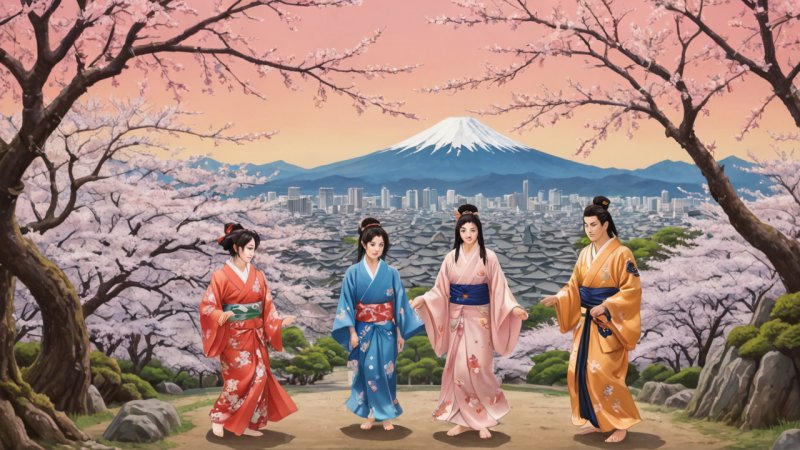Japan, a land steeped in rich traditions and cultural nuances, offers a fascinating tapestry woven with myths and legends that define its identity. From ancient folklore to modern interpretations, these stories have shaped the beliefs, practices, and worldviews of the Japanese people. In this article, we will explore the role of myths and legends in Japanese culture, comparing their impact across different aspects of life including spirituality, art, and social values.
Understanding Myths and Legends
Myths and legends serve as narratives that convey the values and beliefs of a culture. In Japan, these stories often revolve around gods, spirits, and supernatural beings that interact with humans, reflecting the Shinto and Buddhist influences prevalent in the society. Myths tend to explain the origins of the world and humanity, while legends often recount historical events or figures, infusing them with supernatural elements.
Spiritual Significance
One of the most profound roles of myths in Japanese culture is their spiritual significance. The Shinto religion, which is indigenous to Japan, is rich with mythological stories that explain the creation of the Japanese archipelago and the divine ancestry of the imperial family. For instance, the myth of Izanagi and Izanami, who created the islands of Japan, underscores the connection between the land and its people.
In contrast, Buddhist legends, such as those surrounding the life of Buddha and his disciples, emphasize moral teachings and the pursuit of enlightenment. These stories serve to guide followers on their spiritual journeys, illustrating the consequences of actions and the importance of compassion.
Pros and Cons of Spiritual Myths and Legends
- Pros:
- Offer a sense of identity and belonging among the Japanese people.
- Provide a framework for understanding life and the universe.
- Encourage moral behavior and social cohesion.
- Cons:
- Can perpetuate outdated beliefs that may conflict with modern values.
- Risk of oversimplifying complex social issues through allegorical narratives.
Influence on Art and Literature
The influence of myths and legends extends into various forms of art and literature in Japan. Traditional Japanese art forms, such as ukiyo-e, often depict scenes from famous legends or mythological tales. Artists like Katsushika Hokusai and Utagawa Hiroshige have immortalized these stories through their prints, making them accessible to a wider audience.
Moreover, literature has long been a medium for exploring mythological themes. Classic works like “The Tale of the Heike” and “The Tale of Genji” incorporate elements of Japanese mythology, weaving historical narratives with supernatural occurrences. These stories often reflect the human condition, providing insight into the values and struggles of the time.
Pros and Cons of Artistic Representations
- Pros:
- Preserve cultural heritage and historical narratives.
- Inspire new generations of artists and writers.
- Encourage a deeper understanding of ancient beliefs and practices.
- Cons:
- Artistic interpretations may vary, leading to misconceptions of original myths.
- Can romanticize historical events, overshadowing their real-life complexities.
Social Values and Morality
Myths and legends also play a crucial role in shaping social values and moral frameworks in Japan. Many of these stories contain moral lessons that are passed down through generations, reinforcing concepts of honor, loyalty, and respect. The tale of the “47 Ronin,” for instance, exemplifies the virtues of loyalty and sacrifice, serving as a cultural touchstone that resonates with the Japanese ethos.
Additionally, these narratives often address social issues, such as the importance of community and the consequences of greed or betrayal. By integrating such lessons into their myths, societies can cultivate a collective conscience that fosters harmony and cooperation.
Pros and Cons of Moral Lessons
- Pros:
- Encourage ethical behavior and social responsibility.
- Promote unity and a sense of community among individuals.
- Help individuals navigate personal dilemmas through relatable narratives.
- Cons:
- Can lead to rigid moral codes that may not adapt to changing social norms.
- Risk of oversimplifying complex moral dilemmas through binary narratives.
Modern Interpretations and Adaptations
In contemporary Japan, myths and legends continue to evolve, finding new life in various media forms like anime, manga, and film. Creators draw upon traditional stories, reinterpreting them for modern audiences while preserving their core themes. Shows like “Naruto” and “Spirited Away” incorporate mythological elements, sparking interest in Japan's cultural heritage among younger generations.
This adaptation not only serves to entertain but also educates viewers about traditional narratives, ensuring their survival in a fast-paced, globalized world. However, these modern interpretations can sometimes lead to a dilution of the original stories, raising questions about authenticity and cultural representation.
Pros and Cons of Modern Adaptations
- Pros:
- Engage younger audiences, promoting cultural appreciation.
- Encourage innovation and creativity in storytelling.
- Facilitate cross-cultural exchanges through global media.
- Cons:
- May misrepresent or oversimplify traditional narratives.
- Risk losing the cultural significance of myths in favor of entertainment.
Conclusion
Myths and legends serve as a vital component of Japanese culture, influencing spirituality, art, social values, and modern adaptations. While they provide numerous benefits such as fostering a sense of identity, preserving heritage, and imparting moral lessons, there are also challenges that arise from their interpretations and adaptations. Ultimately, the role of myths and legends in Japanese culture is a double-edged sword, offering both profound insights and potential pitfalls. As travelers and enthusiasts delve into Japan's cultural landscape, understanding this dynamic interplay can enrich their experiences and foster a deeper appreciation for the stories that have shaped a nation.






